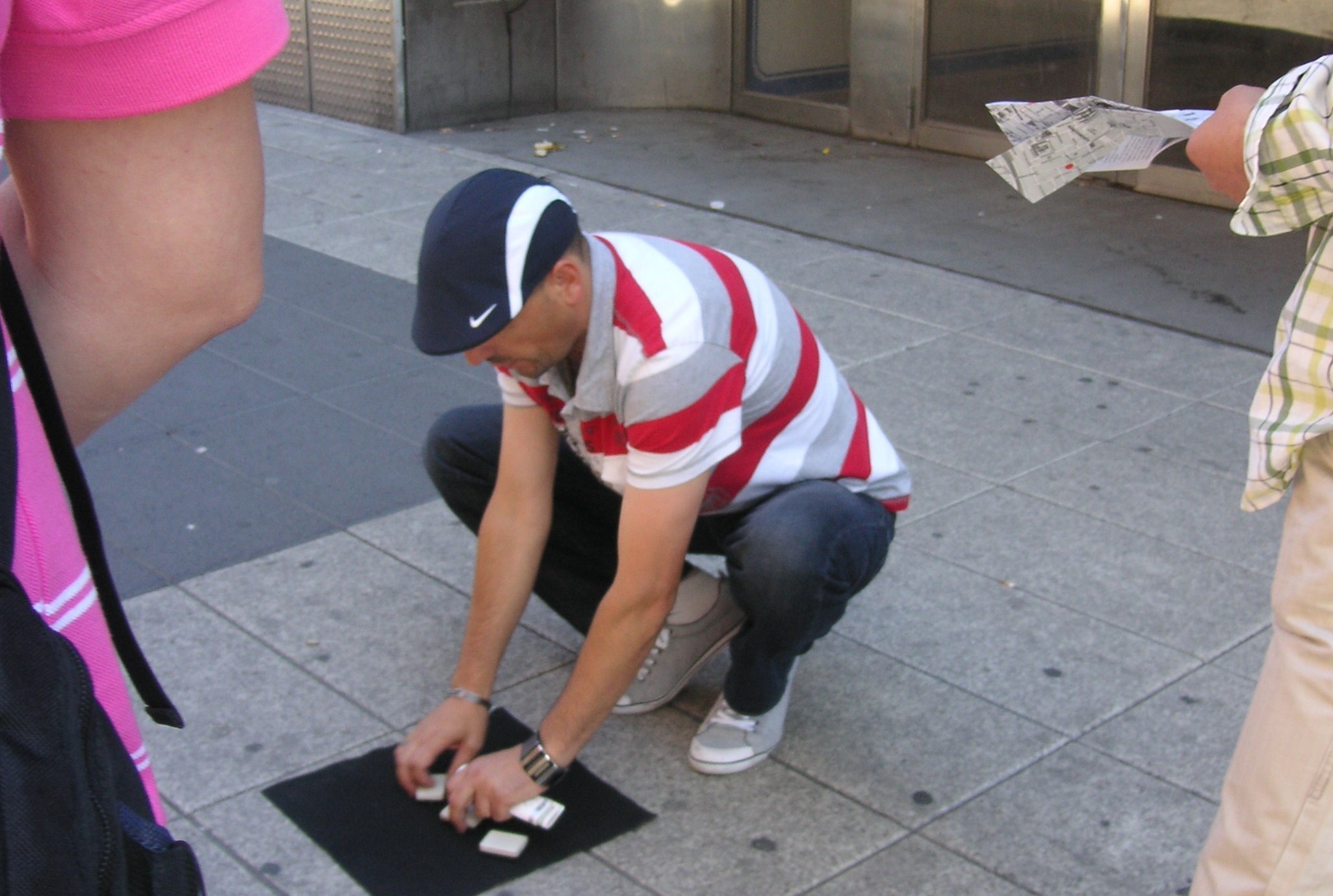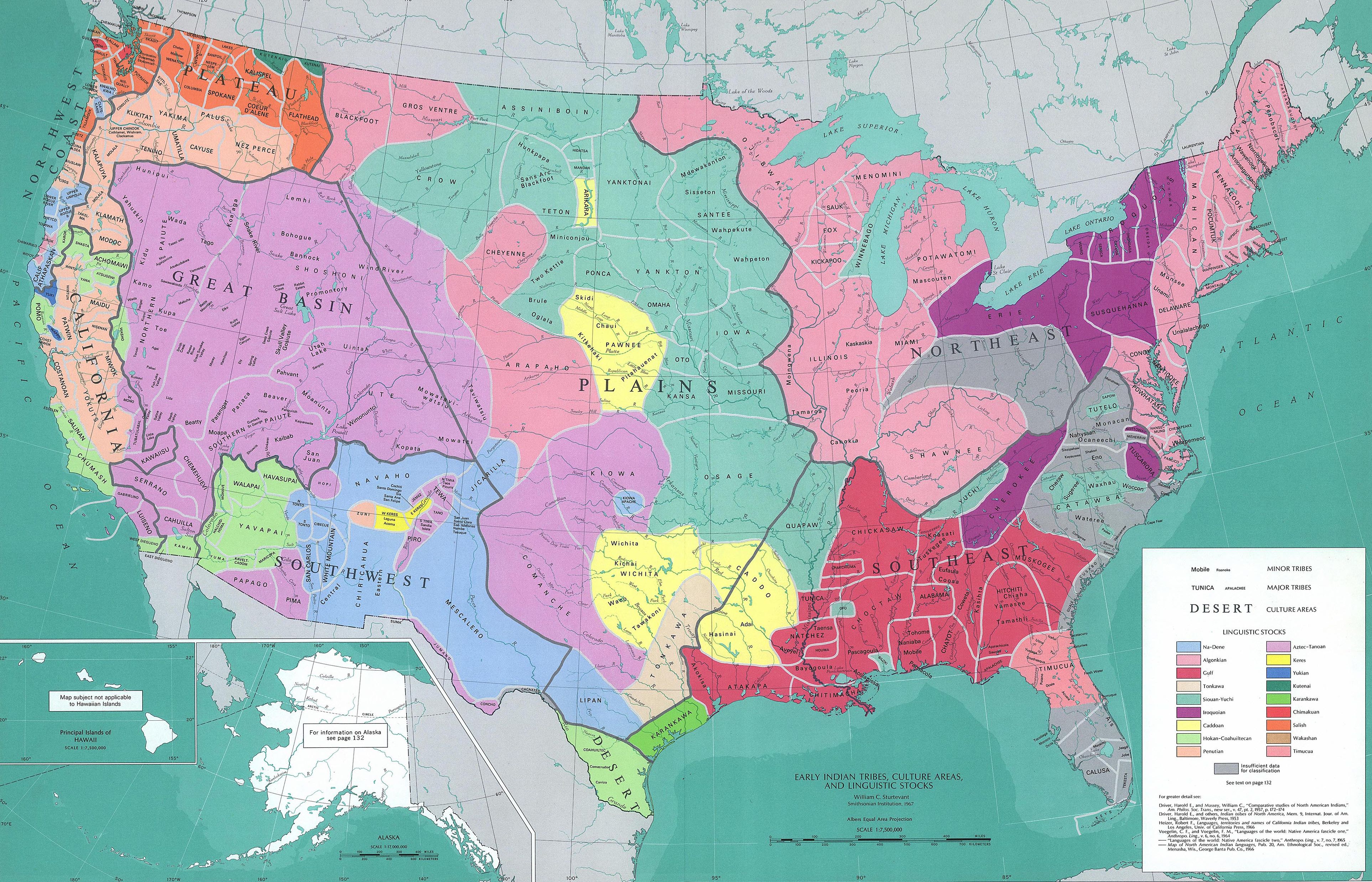|
Moccasin Game
The moccasin game is a gambling game once played by most Native American tribes in North America. In the game, one player hides an object (traditionally a pebble, but more recently sometimes an old bullet or a ball) in one of several moccasins, but in such a way that the other player cannot easily see which moccasin it is in; that player then has to guess which moccasin contains the object. Customarily, the game would be accompanied by music played on drums to distract the guessing player. The game's popularity faded over time, and the old songs were forgotten. By the 1960s only the Chippewa (Ojibwe) of Minnesota and a few other groups still played it. However, in recent years, like many other traditional games (such as lacrosse), moccasin game has seen a resurgence of interest among younger generations. Tournaments are often held during the summer at powwows or other gatherings and are sponsored by a tribe, organization, or family. Haƞpap̣ena In Dakota, the moccasin game ... [...More Info...] [...Related Items...] OR: [Wikipedia] [Google] [Baidu] |
Gambling
Gambling (also known as betting or gaming) is the wagering of something of Value (economics), value ("the stakes") on a Event (probability theory), random event with the intent of winning something else of value, where instances of strategy (game theory), strategy are discounted. Gambling thus requires three elements to be present: consideration (an amount wagered), risk (chance), and a prize. The outcome of the wager is often immediate, such as a single roll of dice, a spin of a roulette wheel, or a horse crossing the finish line, but longer time frames are also common, allowing wagers on the outcome of a future sports contest or even an entire sports season. The term "gaming" in this context typically refers to instances in which the activity has been specifically permitted by law. The two words are not mutually exclusive; ''i.e.'', a "gaming" company offers (legal) "gambling" activities to the public and may be regulated by one of many gaming control boards, for example, the ... [...More Info...] [...Related Items...] OR: [Wikipedia] [Google] [Baidu] |
Native Americans In The United States
Native Americans (also called American Indians, First Americans, or Indigenous Americans) are the Indigenous peoples of the Americas, Indigenous peoples of the United States, particularly of the Contiguous United States, lower 48 states and Alaska. They may also include any Americans whose origins lie in any of the indigenous peoples of North or South America. The United States Census Bureau publishes data about "American Indians and Alaska Natives", whom it defines as anyone "having origins in any of the original peoples of North and South America ... and who maintains tribal affiliation or community attachment". The census does not, however, enumerate "Native Americans" as such, noting that the latter term can encompass a broader set of groups, e.g. Native Hawaiians, which it tabulates separately. The European colonization of the Americas from 1492 resulted in a Population history of Indigenous peoples of the Americas, precipitous decline in the size of the Native American ... [...More Info...] [...Related Items...] OR: [Wikipedia] [Google] [Baidu] |
Moccasin
A moccasin is a shoe, made of deerskin or other soft leather, consisting of a sole (made with leather that has not been "worked") and sides made of one piece of leather, stitched together at the top, and sometimes with a vamp (additional panel of leather). The sole is soft and flexible and the upper part often is adorned with embroidery or beading. Though sometimes worn inside, it is chiefly intended for outdoor use. Historically, it is the footwear of many indigenous people of North America; moreover, hunters, traders, and European settlers wore them. Etymologically, the ''moccasin'' derives from the Algonquian language Powhatan word ''makasin'' (cognate to Massachusett ''mohkisson'' / ''mokussin'', Ojibwa ''makizin'', Mi'kmaq ''mksɨn''), and from the Proto-Algonquian word *''maxkeseni'' (shoe). History In the 1800s, moccasins usually were part of a Canadian regalia, e.g. a powwow suit of clothes. The most common style is that of the Plains Indians moccasin. Moccasi ... [...More Info...] [...Related Items...] OR: [Wikipedia] [Google] [Baidu] |
Ojibwe
The Ojibwe (; Ojibwe writing systems#Ojibwe syllabics, syll.: ᐅᒋᐺ; plural: ''Ojibweg'' ᐅᒋᐺᒃ) are an Anishinaabe people whose homeland (''Ojibwewaki'' ᐅᒋᐺᐘᑭ) covers much of the Great Lakes region and the Great Plains, northern plains, extending into the subarctic and throughout the northeastern woodlands. The Ojibwe, being Indigenous peoples of the Northeastern Woodlands and of Indigenous peoples of the Subarctic, the subarctic, are known by several names, including Ojibway or Chippewa. As a large ethnic group, several distinct nations also consider themselves Ojibwe, including the Saulteaux, Nipissings, and Oji-Cree. According to the U.S. census, Ojibwe people are one of the largest tribal populations among Native Americans in the United States, Native American peoples in the U.S. In Canada, they are the second-largest First Nations in Canada, First Nations population, surpassed only by the Cree. They are one of the most numerous Indigenous peoples of t ... [...More Info...] [...Related Items...] OR: [Wikipedia] [Google] [Baidu] |
Mille Lacs Indian Reservation
Mille Lacs Indian Reservation is the popular name for the land-base for the Mille Lacs Band of Ojibwe in Central Minnesota, about 100 miles (160 km) north of Minneapolis-St. Paul. The contemporary Mille Lacs Band reservation has significant land holdings in Mille Lacs, Pine, Aitkin and Crow Wing counties, as well as other land holdings in Kanabec, Morrison, and Otter Tail Counties. Mille Lacs Indian Reservation is also the name of a formal Indian reservation established in 1855. It is one of the two formal reservations on which the contemporary Mille Lacs Band retains land holdings. The contemporary Mille Lacs band includes several aboriginal Ojibwe bands and villages, whose members reside in communities throughout central Minnesota. Reservations Mille Lacs Lake Indian Reservation The main reservation of the Mille Lacs Indian Reservation is the Mille Lacs Lake Indian Reservation (''Misi-zaaga'iganiing'' in the Ojibwe language), at , and commonly referred to as the ... [...More Info...] [...Related Items...] OR: [Wikipedia] [Google] [Baidu] |
Apache
The Apache ( ) are several Southern Athabaskan language-speaking peoples of the Southwestern United States, Southwest, the Southern Plains and Northern Mexico. They are linguistically related to the Navajo. They migrated from the Athabascan homelands in the north into the Southwest between 1000 and 1500 CE. Apache bands include the Chiricahua, Jicarilla Apache, Jicarilla, Lipan Apache people, Lipan, Mescalero, Mimbreño Apache, Mimbreño, Salinero Apaches, Salinero, Plains Apache, Plains, and Western Apache (San Carlos Apache Indian Reservation, Aravaipa, Pinaleño Mountains, Pinaleño, Fort Apache Indian Reservation, Coyotero, and Tonto Apache, Tonto). Today, Apache tribes and Indian reservation, reservations are headquartered in Arizona, New Mexico, Texas, and Oklahoma, while in Mexico the Apache are settled in Sonora, Chihuahua, Coahuila and areas of Tamaulipas. Each Native American tribe, tribe is politically autonomous. Historically, the Apache homelands have consisted of ... [...More Info...] [...Related Items...] OR: [Wikipedia] [Google] [Baidu] |
Geronimo
Gerónimo (, ; June 16, 1829 – February 17, 1909) was a military leader and medicine man from the Bedonkohe band of the Ndendahe Apache people. From 1850 to 1886, Geronimo joined with members of three other Central Apache bands the Tchihende, the Tsokanende (called Chiricahua by Americans) and the Nednhito carry out numerous raids, as well as fight against Mexican and U.S. military campaigns in the northern Mexico states of Chihuahua and Sonora and in the southwestern American territories of New Mexico and Arizona. Geronimo's raids and related combat actions were a part of the prolonged period of the Apache–United States conflict, which started with the Americans continuing to take land, including Apache lands, following the end of the war with Mexico in 1848. Reservation life was confining to the free-moving Apache people, and they resented restrictions on their customary way of life. Geronimo led breakouts from the reservations in attempts to return his people to th ... [...More Info...] [...Related Items...] OR: [Wikipedia] [Google] [Baidu] |
Moccasins
A moccasin is a shoe, made of deerskin or other soft leather, consisting of a sole (made with leather that has not been "worked") and sides made of one piece of leather, stitched together at the top, and sometimes with a vamp (additional panel of leather). The sole is soft and flexible and the upper part often is adorned with embroidery or beading. Though sometimes worn inside, it is chiefly intended for outdoor use. Historically, it is the footwear of many indigenous people of North America; moreover, hunters, traders, and European settlers wore them. Etymologically, the ''moccasin'' derives from the Algonquian language Powhatan word ''makasin'' (cognate to Massachusett ''mohkisson'' / ''mokussin'', Ojibwa ''makizin'', Mi'kmaq ''mksɨn''), and from the Proto-Algonquian word *''maxkeseni'' (shoe). History In the 1800s, moccasins usually were part of a Canadian regalia, e.g. a powwow suit of clothes. The most common style is that of the Plains Indians moccasin. Mocca ... [...More Info...] [...Related Items...] OR: [Wikipedia] [Google] [Baidu] |
Creation Story
A creation myth or cosmogonic myth is a type of cosmogony, a symbolic narrative of how the world began and how people first came to inhabit it., "Creation myths are symbolic stories describing how the universe and its inhabitants came to be. Creation myths develop through oral traditions and therefore typically have multiple versions." While in popular usage the term ''myth'' often refers to false or fanciful stories, members of cultures often ascribe varying degrees of truth to their creation myths. In the society in which it is told, a creation myth is usually regarded as conveying profound truthsmetaphorically, symbolically, historically, or literally. They are commonly, although not always, considered cosmogonical mythsthat is, they describe the ordering of the cosmos from a state of chaos or amorphousness. Creation myths often share several features. They often are considered sacred accounts and can be found in nearly all known religious traditions. They are all stories wi ... [...More Info...] [...Related Items...] OR: [Wikipedia] [Google] [Baidu] |
Club (weapon)
A club (also known as a cudgel, baton, bludgeon, truncheon, cosh, nightstick, or impact weapon) is a short staff or stick, usually made of wood, wielded as a weapon or tool since prehistory. There are several examples of blunt trauma, blunt-force trauma caused by clubs in the past, including at the site of Nataruk in Turkana County, Turkana, Kenya, described as the scene of a prehistoric conflict between bands of hunter-gatherers 10,000 years ago. Most clubs are small enough to be swung with one hand, although larger clubs may require the use of two to be effective. Various specialized clubs are used in martial arts and other fields, including the Baton (law enforcement), law-enforcement baton. The military Mace (bludgeon), mace is a more sophisticated descendant of the club, typically made of metal and featuring a spiked, knobbed, or flanged head attached to a shaft. Examples of cultural depictions of clubs may be found in mythology, where they are associated with strong figure ... [...More Info...] [...Related Items...] OR: [Wikipedia] [Google] [Baidu] |
Shell Game
The shell game (also known as thimblerig, three shells and a pea, the old army game) is a public gambling game that challenges players to follow the movement of a marker hidden under one of several covers (shells). In practice, the game is almost always run as a confidence trick that uses sleight of hand to transfer the marker between covers. In confidence trick slang, this swindle is referred to as a ''short-con'' because it is quick and easy to pull off. The shell game is related to the cups and balls conjuring trick, which is performed purely for entertainment purposes without any purported gambling element. Play In the shell game, three or more identical containers (which may be cups, shells, bottle caps, or anything else) are placed face-down on a surface. A small ball is placed beneath one of these containers so that it cannot be seen, and they are then shuffled by the operator in plain view. One or more players are invited to bet on which container holds the ball – ty ... [...More Info...] [...Related Items...] OR: [Wikipedia] [Google] [Baidu] |
Native American Culture
Native American cultures across the 574 current federally recognized tribes in the United States, can vary considerably by language, beliefs, customs, practices, laws, art forms, traditional clothing, and other facets of culture. Yet along with this diversity, there are certain elements which are encountered frequently and shared by many tribal nations. European colonization of the Americas had a major impact on Native American cultures through what is known as the Columbian exchange. Also known as the ''Columbian interchange'', this was the spread transfer of plants, animals, culture, human populations, technology, and ideas between the Americas and the Old World in the 15th and 16th centuries, following Christopher Columbus's 1492 voyage. The Columbian exchange generally had a destructive impact on Native American cultures through disease, and a 'clash of cultures', whereby European values of private property, smaller family structures, and labor led to conflict, appropr ... [...More Info...] [...Related Items...] OR: [Wikipedia] [Google] [Baidu] |








